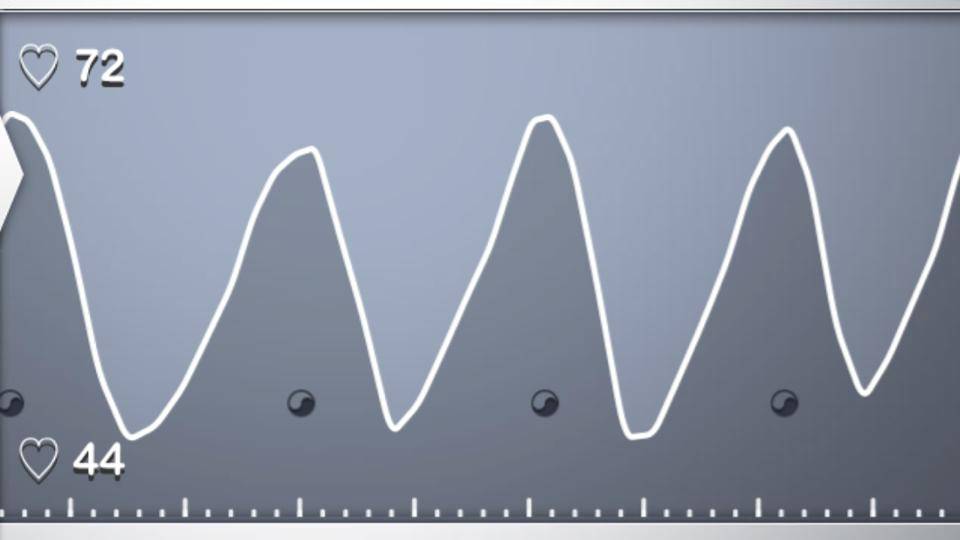In this blog I will be discussing how to monitor and reduce your stress levels by using your heart rate, some simple berthing exercises and some other ‘tricks’. You can very simply improve you overall internal health, especially that of your nervous system and your immune system by increasing your heart rate variability (HRV). This can be most easily done if you can learn to inhale for 6 seconds and exhale for 6 seconds .
The heart appears to work in a 12 second cycle when you are resting or doing simple tasks. You can synchronise your breathing to your heart rate by inhaling for 6 seconds as your heart rate increases, and your exhale for 6 seconds as your heart rate decreases.

Figure 1: Heart rate variability in an adult with controlled slow breathing: horizontal axis is time, vertical axis is heart rate, ascending lines correspond to slow controlled inhalation, descending lines correspond to slow controlled exhalation; by Simon Borg-Olivier (click on this image for full photo)
This photo shows a graph of my heart rate variability (HRV) over 5 smooth breaths in a simple seated posture. Notice how on inhalation (line going up) my heart rate goes up to as high as 72 beats per minute. Then when I exhale (line going down) my heart rate goes down to as low as 42 beats per minute. Increased HRV is one the best indicators of internal health. Good yoga can easily teach this. For adults HRV is generally very poor without something like good yoga in your life.
Much of the yoga practices I see around the world actually causes more stress (and worse HRV) than good health. Yoga is ideally the art of doing stressful things while being relaxed yet getting stronger and fitter. My nine year old daughter Amaliah did this exercise and her HRV went back and forth between 38 to 115 beats per minute on each breath while just sitting relaxed for a few minutes. Now that’s the healthy state most kids have! Adults have to work for it!
I took these photos using the App called Stress Doctor. More about this App and HRV below …
Stress Doctor is a great mobile app that helps you reduce your stress level in just 5 minutes.
Stress Doctor relies on proven biofeedback techniques to help sync your breathing with your autonomous nervous system (ANS). This synchronization increases your Heart Rate Variability (HRV), which in turn lowers your heart rate, reduces your stress and anxiety levels and controls your blood flow.
HRV and Stress
HRV is the variation in interval between heartbeats. High HRV is achieved when a person is relaxed and breathing slowly.
Respiratory Sinus Arrhythmia (RSA) is a naturally occurring variation in heart rate that occurs during a breathing cycle and is directly proportional to HRV. Higher RSA (higher HRV) is indicative of a nervous system that is more equipped to handle stress.
HRV biofeedback training includes monitoring RSA and adjusting breathing patterns to increase HRV. This training is an effective tool to moderate stress and anxiety levels and depressed mood.
Effect of Breathing
Your heart rate varies naturally, increasing during inhalation and decreasing during exhalation. Breathing influences the transmission of sympathetic and vagus impulses to control your heart rate. The vagus nerve reduces heart rate and the force of contraction, and is primarily responsible for controlling the heart’s rhythm. When we inhale, the vagus nerve activity is reduced and the heart rate increases. On exhale, activity is increased and heart rate decreases.
Because the breathing pattern required to stimulate your optimum level of vagus impulses is unique to each individual, biofeedback is necessary to determine the breathing pattern that best aligns with your nervous system. A long exhale for instance is usually considered good for relaxation, however exhaling too long can be ineffective.
Stress Doctor measures your RSA, determines the optimum level of vagal activity to maximize HRV, and paces you through your ideal breathing pattern to achieve a higher HRV, which in turn reduces stress and anxiety levels and improves overall mood. You can download the Stress Doctor App from iTunes for free if you have an iPhone – unfortunately I cant seem to find an android version of this app yet but I will keep looking.
HRV and Your Vagus Nerve
Heart rate variability decreases with stress and also with age. Increasing your heart rate variability is thus very important and it can be controlled by the vagus nerve. Learning how to relax and increasing vagal activity is essential for good health. Stimulating the vagus nerve can:
* Increase your heart rate variability
* Increases stomach acid (essential for digestive health)
* Lowers blood pressure
* Help regenerate your organs and cells by activating stem cells
* Increase brain size
* Reduce inflammation
* Increase immune function
* Regulate your nervous system
* Help reduce stress and depression
* Helps to decrease migraines
* Enhance quality of life
* Improve performance ability
Share this Post


Comments 3
Pingback: How to reduce stress by yoga | Quik Answer
Hi Simon
Thanks so much for sharing!! I am curious about how you said ‘A long exhale for instance is usually considered good for relaxation, however exhaling too long can be ineffective.’ I wonder what you mean exactly? im a yoga teacher and mental health social worker and often teach extended exhalation to kick in parasympathetic NS, thanks so much , Karen
Author
Hi Karen
When I say a long exhale I am talking about the effects of really long exhales on heart rate variability. I can for 2 minutes and by the end of that time heart rate usually increases and sympathetic nervous system seems to kick in more – but most people talk about a long exhale being much less time. I hope that clarifies a bit – but ask more if you wish – cheers, simon